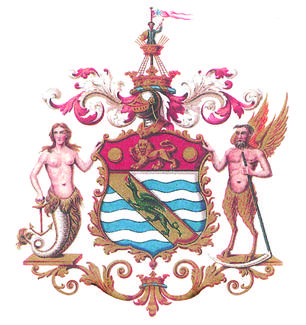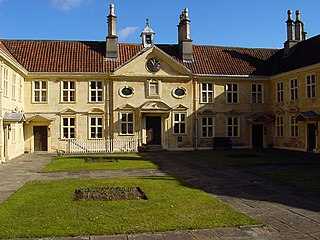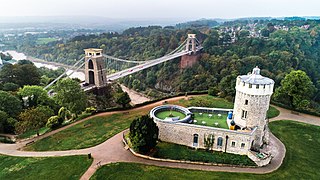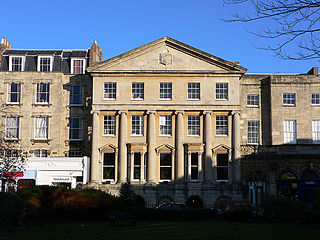
Great Linford is a historic village, district and wider civil parish in the northern part of Milton Keynes, England, between Wolverton and Newport Pagnell.

The Society of Merchant Venturers is a charitable organisation in the English city of Bristol.

Bristol Harbour is the harbour in the city of Bristol, England. The harbour covers an area of 70 acres. It is the former natural tidal river Avon through the city but was made into its current form in 1809 when the tide was prevented from going out permanently. A tidal by-pass was dug for 2 miles through the fields of Bedminster for the river, known as the "River Avon New Cut", "New Cut", or simply "The Cut". It is often called the Floating Harbour as the water level remains constant and it is not affected by the state of the tide on the river in the Avon Gorge, The New Cut or the natural river southeast of Temple Meads to its source.

The Museum of the Home, formerly the Geffrye Museum, is a free museum in the 18th-century Grade I-listed former almshouses on Kingsland Road in Shoreditch, London. The museum explores home and home life from 1600 to the present day with galleries which ask questions about 'home', present diverse lived experiences, and examine the psychological and emotional relationships people have with the idea of "home" alongside a series of period room displays.

Edward Colston was an English merchant, slave trader, philanthropist, and Tory Member of Parliament.

Blaise Castle is a folly built in 1766 near Henbury in Bristol, England. The castle sits within the Blaise Castle Estate, which also includes Blaise Castle House, a Grade II* listed 18th-century mansion house. The folly castle is also Grade II* listed and ancillary buildings including the orangery and dairy also have listings. Along with Blaise Hamlet, a group of nine small cottages around a green built in 1811 for retired employees, and various subsidiary buildings, the parkland is listed Grade II* on the Register of Historic Parks and Gardens of special historic interest in England.

Bristol, the largest city in South West England, has an eclectic combination of architectural styles, ranging from the medieval to 20th century brutalism and beyond. During the mid-19th century, Bristol Byzantine, an architectural style unique to the city, was developed, and several examples have survived.

Stoke Bishop is a medium-sized outer city suburb in the north-west of Bristol, located in between Westbury-on-Trym, Sneyd Park, and Sea Mills. Although relatively low, Stoke Bishop's population has increased due to substantial infilling on the Smelting Works sports ground and The Grove which used to belong to Clifton High school. The population of Stoke Bishop varies throughout the year because of the influx of students to the large campus of Bristol University halls of residence situated on the edge of the suburb and the Downs during term time.

Montpelier High School is a girls secondary Academy, located in the Montpelier area of Bristol, England. The school building was designed by William Venn Gough and dates from 1891. It uses a polychrome mix of various Northern Renaissance styles, built in red Cattybrook brick with yellow brick and buff terracotta dressings, and has been designated by English Heritage as a grade II listed building.

Bristol Beacon, previously known as Colston Hall, is a concert hall and Grade II listed building on Colston Street, Bristol, England. It is owned by Bristol City Council. Since 2011, management of the hall has been the direct responsibility of Bristol Music Trust.

King Street is a 17th-century street in the historic city centre of Bristol, England.

Colstons Almshouses is a historic building on St Michaels Hill, Bristol, England. It was built in 1691 and has been designated by Historic England as a Grade I listed building. The front wall and gates are also Grade I listed. They are named after the Bristol-born merchant, philanthropist, slave trader, and Member of Parliament Edward Colston.

Clifton Observatory is a former mill, now used as an observatory, located on Clifton Down, close to the Clifton Suspension Bridge, Bristol, England.

Foster's Almshouse is a historic building on Colston Street, Bristol, England. The almshouse was founded by a bequest from the 15th-century merchant John Foster in 1492; his will can be read online.

The Chapel of the Three Kings of Cologne is a church in Colston Street, near the top of Christmas Steps, Bristol, England. It has been designated as a Grade II* listed building.

The Alderman Proctor's Drinking Fountain is a historic building on Clifton Down, Bristol, England.

The Merchant Hall is a historic building on The Promenade, Clifton Down, Bristol, England.

The Clifton Club is a traditional private members club in Bristol, England, founded in 1818 as a meeting place for the gentlemen of the prosperous port of Bristol.

The Percy and Wagner Almshouses are a group of 12 almshouses in the inner-city Hanover area of the English coastal city of Brighton and Hove. The first six date from 1795 and are among the few pre-19th-century buildings left in the city. Six more were added in a matching style in 1859. They are the only surviving almshouses in Brighton and have been listed at Grade II for their architectural and historical importance.




















